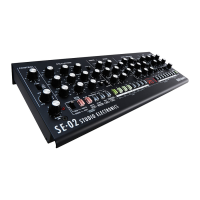TRIGGER
The SE-02 offers a TRIGGER IN and TRIGGER OUT connector on the back of the synthesizer. This serves as
a method of interacting with various other clock and rhythm sources and the internal sequencer of the SE-02.
TRIGGER IN
This is for connecting an external pattern or clock source to control the performance of the internal pattern
sequencer of the SE-02.
1. Set the SEQUENCER clock source to“trg"
2. Connect the GATE or TRIGGER output of your external sequencer to the TRIGGER IN jack on the SE-02
3. Play the external sequence.
Notice that the sequencer of the SE-02 will only advance to the next step of the pattern when a TRIGGER pulse
is received. This means that the timing of the internal sequencer can be made flexible, and very interesting
results can come as the result of programming interesting TRIGGER pulses.
To achieve typical timing, enter a [1, 3, 5, 7, 9, 11, 13, 15] TRIGGER pattern from the external sequencer to
produce a standard clock. 16 note sequences are accomplished by entering a
[1,2,3,4,5,6,7,8,9,10,11,12,13,14,15,16] TRIGGER pattern. This will appear to send the SE-02 sequence into
double time, but remain in sync. For “half time” send a pattern programmed with [1,5, 9, 13].
As you can see this gets really fun and interesting. By sending various trigger patterns to the TRIGGER input
of the SE-02, different timing is achieved without making any changes to the internal sequence of the SE-02.
Experiment:
1. Select a pattern in the sequencer of the SE-02 that you like.
2. Connect the trigger out of a TR-09 (or other equipped sub sequencer/drum machine) to the TRIGGER IN
jackofthe SE-02.
3. Program the steps 1,3,5,9,13 into the external sequencer and press PLAY
4. Listen to the 5 note pattern play in time together with the external sequencer.
5. Adjust the notes on the external device. Shift them around, take a few away, and add a few more. Play with
meter whilst remaining in time. Isn’t that cool? What a lovely way to discover musical ideas which you might
not have intuitively sat down and performed without such an exploration.
TRIGGER OUT
This is for connecting the internal sequencer of the SE-02 to external devices for sending trigger pulses. So it’s
basically for the reverse of the TRIGGER IN and this allows you to use the internal sequencer of the SE-02 as
a pulse source for controlling the sequencer of an external device.
1. Set the SEQUENCER clock source to “Int” (or midi if your master clock is coming externally via MIDI)
2. Connect the GATE or TRIGGER input of your external sequencer to the TRIGGER OUT jack on the SE-02
3. Play the internal sequence.
Notice that the external sequencer will only advance to the next step of the pattern when a TRIGGER pulse
is received. This means that the timing of the external sequencer can be made flexible, and interesting
results can come as the result of programming interesting TRIGGER pulses.
Experiment: Consider the SE-02 internal sequence controlling the rhythmic content of a drum pattern. Now
consider controlling the pattern clock of another synthesizer. Program a pattern into another Roland Boutique
synth which receives trigger input (like the TB-03) and control the pattern’s steps from the internal sequencer of
the SE-02. What a far out method of asking two devices to relate to one another. Get into this. Explore.
Page 30 of 35 Manual V1.03 for firmware V1.11

